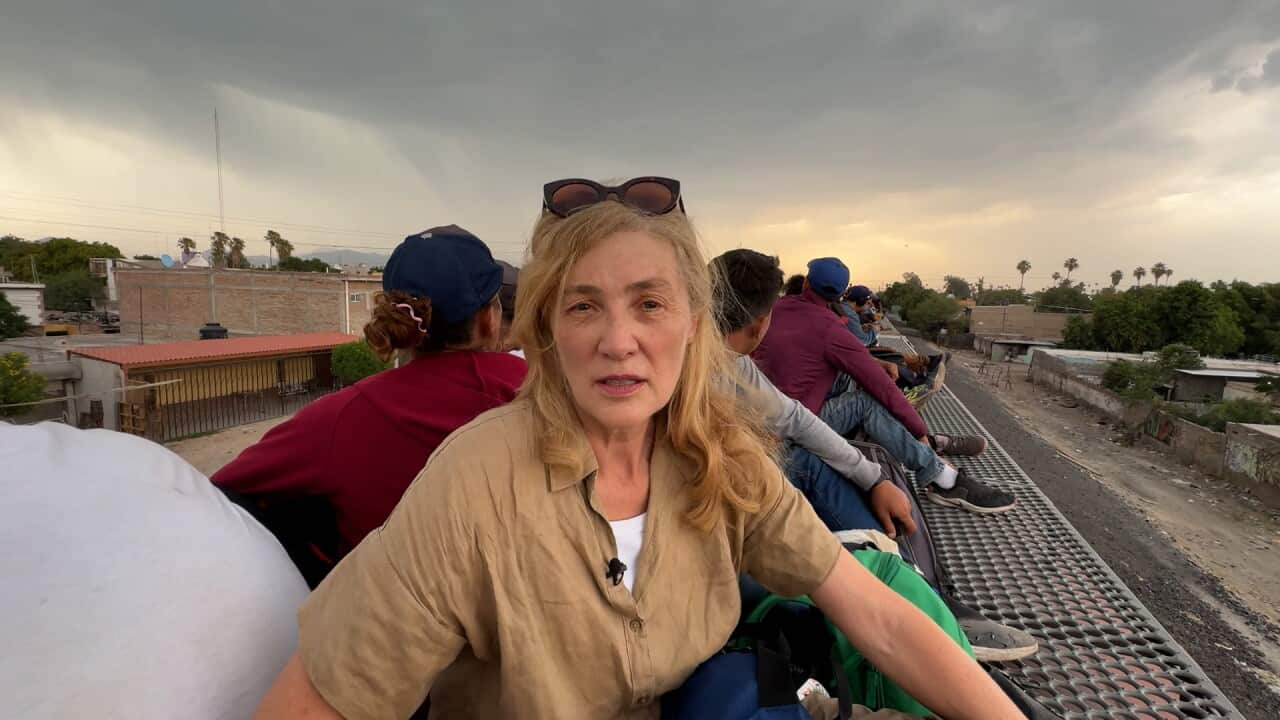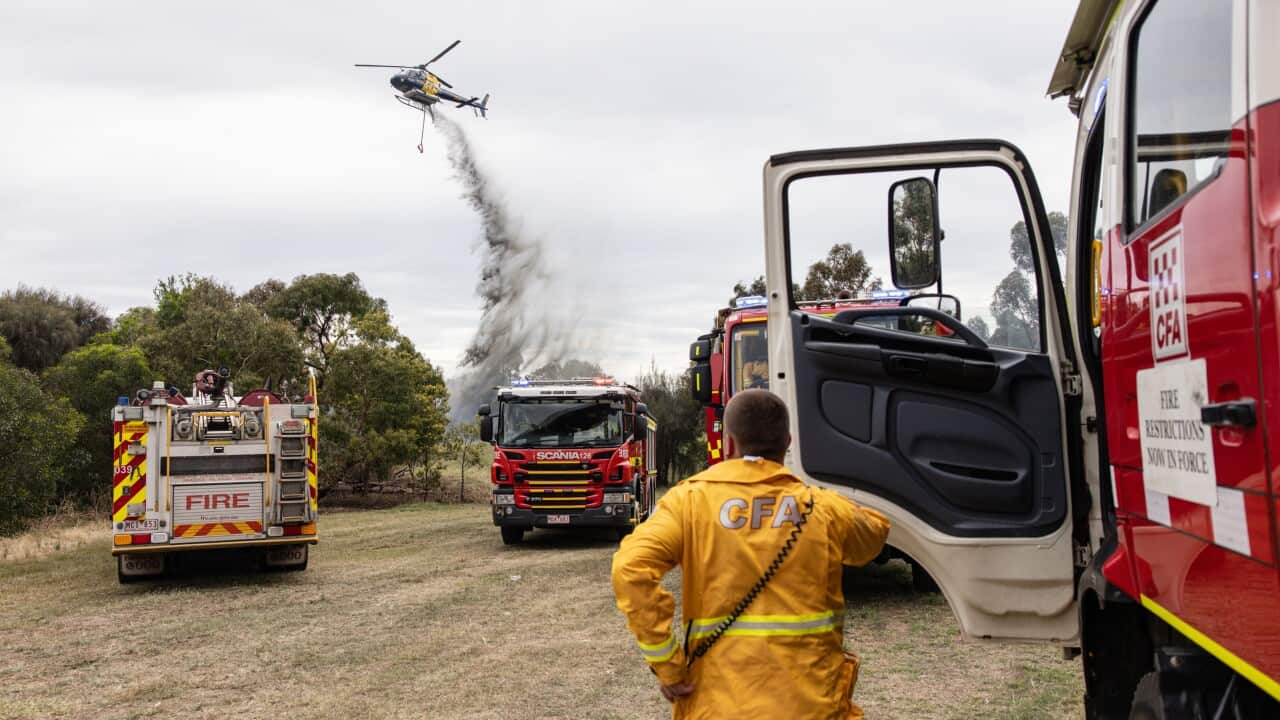Watch The Beast: Mexico’s Deadliest Train on Tuesday 17 September at 9:30pm on SBS.
On a hot night in Irapuato, central Mexico, we wait beside the tracks for ‘The Beast’.
It’s a huge freight train that travels through Mexico’s forbidding landscape — across wilderness and desert — to the southern US border.
For the poorest of the poor who seek a better life, riding The Beast is often a last resort.
Designed for freight, not families, these desperate travellers ride atop the carriages, exposed to wind, sun and relentless heat for days on end.
We are 1,500 km from Ciudad Juarez, on the US border.
Only the most desperate of would-be US immigrants ride what Spanish speakers call La Bestia (The Beast) or El Tren de la Muerte (The Train of Death).
Maria (not her real name) had already trekked the Darien Gap — the deadly jungle passage between Colombia and Panama thousands of kilometres south — after leaving her home in Venezuela a year ago.
She’s my introduction to the struggles of migrants trying to get to the US against all odds in 2024.
Waiting for The Beast, she is perched on the railway tracks with a winning, welcoming smile.
She is plucky and determined — and only five.
Five-year-old ‘Maria’ from Venezuela left home with her mum a year ago.
‘La Bestia’
In Spanish, the train is known as ‘La Bestia’ — The Beast. It’s also called ‘El Tren de la Muerte’ — the Train of Death.
Over the years, The Beast has taken more than enough lives and severed enough limbs to earn its title.
Migrants from Central and South America passing north through Mexico have no safe passage on their journey to the US; they are vulnerable to extortionists and gangs and must avoid migration agents who can detain them.
Hitching a free ride on top of one of Mexico’s freight trains is just one of the many dangerous obstacles some must overcome to reach their destination.
Over the years, The Train of Death, also known as The Beast, has taken more than enough lives and severed enough limbs to earn its titles.
Thousands of migrants attempt to ride the train north every month, despite the risk of death and injury.
Immigration has emerged as one of the most contentious issues in the November US presidential election
But the migrants on The Beast seem impervious to not being welcomed or wanted in the place they hope to live.
The train departs
Genesis, Maria’s mum, holds her kids tightly as The Beast thunders into view, barrels past and screeches to a stop.
Suddenly, all our preparations seem irrelevant; we’re stumbling in the dark.
“Run, run, run!” a man screams to his child.
A young woman in front of me is wailing: “I don’t have my daughter. I don’t have my daughter! Where is she?”
Nearly everyone has waited for a train at some point their lives, but nothing compares to the chaos of the moment The Beast pulls up. Migrants scramble to climb aboard, but they have no idea when it will start moving again.
We have to climb on before The Beast moves again.
On top of the sooty wagon, I spot Genesis and her kids.
I also see Julianiss — the young mum who’d momentarily lost sight of her daughter — and Carlos, a 22-year-old car salesman with a grin so sweet it seems like he could probably sell umbrellas in a drought.
Everyone appears to have safely made it.
There’s a brief moment of joy as The Beast pulls away into the darkness.
The Beast travels over 1,500km from Mexico City to the city of Ciudad Juarez, on the southern US border.
Then the wagon erupts into song — Venezuela’s national anthem — another revealing moment.
“Maduro!” someone shouts — a reference to Venezuelan President Nicolas Maduro.
“Mother f—er!” comes the reply.
Riding the beast on this night are just a handful of the millions who have left Venezuela over the past decade.
After July’s presidential election, more are preparing to leave.
Not a single migrant to whom I spoke countenances any notion of going back.
Despite having the world’s largest known oil reserves, Venezuela’s gross domestic product (GDP) has dropped by 80 per cent in a decade.
More than 7.8 million of its citizens have fled.
Also riding The Beast that night are Ecuadorians, fleeing violent crime and Nicaraguans escaping a government crackdown on political dissent.
A dread-inducing encounter
We slide through the cooling night — though not for long.
Within two hours, the train is stopped by agents from the Instituto Nacional de Migración, Mexico’s migration authority, who are accompanied by soldiers.
Almost nothing fills these migrants with dread like encountering migration agents.
At this point, we have no idea where we are. Scared, sleepy children stare down at men with weapons. Grown men cower.
Within two hours of boarding The Beast, the train is stopped by agents from Mexico’s migration authority, accompanied by soldiers, who demand the migrants finish their journey on foot.
“You must get off and keep going on foot,” one of the agents shouts up to our wagon.
We are still around 1,300km from the US border.
One agent addresses me personally: “The Army will come to get you off.”
The wagons explode in uproar.
It isn’t just a case of distance; there’s the ever-present threat of predatory criminals and of being detained and sent to the south of Mexico where the only options for the migrants are to start over or give up.
But no one in our wagon is of a mind to quit.
“We want to keep going,” they chant over and over.
Maria wakes from a nap and joins in.
For reasons I still can’t fathom, the agents eventually relent and the soldiers leave.
It has only been a couple of hours, but in that short window of time the migrants had skidded through anticipation, panic, dread and relief.
Now they sleep.
Exposed to the elements
For twelve days, through many indignities and danger, I track the migrants as they try to reach Ciudad Juarez, the Mexican town just across the border from El Paso, Texas.
The migrants often have no money, not enough water, and no place to privately go to the toilet.
When the migrants are forced off one train and waiting for the next it’s a case of sleeping on concrete — on the pavement in Torreon, about 700km north of where their journey started, and on another sidewalk in the nearby city of Gomez Palacio.
Sometimes concrete is a sweet relief — at least compared to trying to sleep while on The Beast.
Migrants face days of discomfort crammed into a wagon, but climbing off for a comfort break means running the risk of getting left behind.
Just when I fear I’ve lost them, Maria comes running up to me.
Her mum had been a pastry cook in Venezuela.
One morning, after a night on the pavement, I ask Genesis when she had last slept in a bed.
She has to think for a bit. “The last time, in a bed? I think in Guatemala. Because in Mexico, I didn’t.”
And, yet, she has no regrets.
Migrants riding freight trains often face blistering heat and a lack of water, and they risk dying of dehydration.
With around another 800km until the US border, another Beast comes hurtling down the tracks.
A desperate man throws himself at the passing wagon, ricochets off it like a rag doll, and is thrown to the ground in a bloodied mess.
Scarlet — a young, pregnant woman from Honduras — is groaning in pain — she has gone into labour. Yet she hauls herself up on The Beast like everyone else.
Prue Lewarne witnessed the determination of desperate people who felt they had no option but to make the dangerous journey.
Harri, a dad from Venezuela, had helped her survive through Mexico as best he could. Now he is frantic.
“Not Migration, not Migration. Migration will deport her!” Even as she lies beside the tracks, fear of the migration agents is paramount.
Many hundreds of kilometres remain between the migrants and the US border, where they will face the challenge of crossing the razor-wire border fence.
But for them, there is no going back.





















